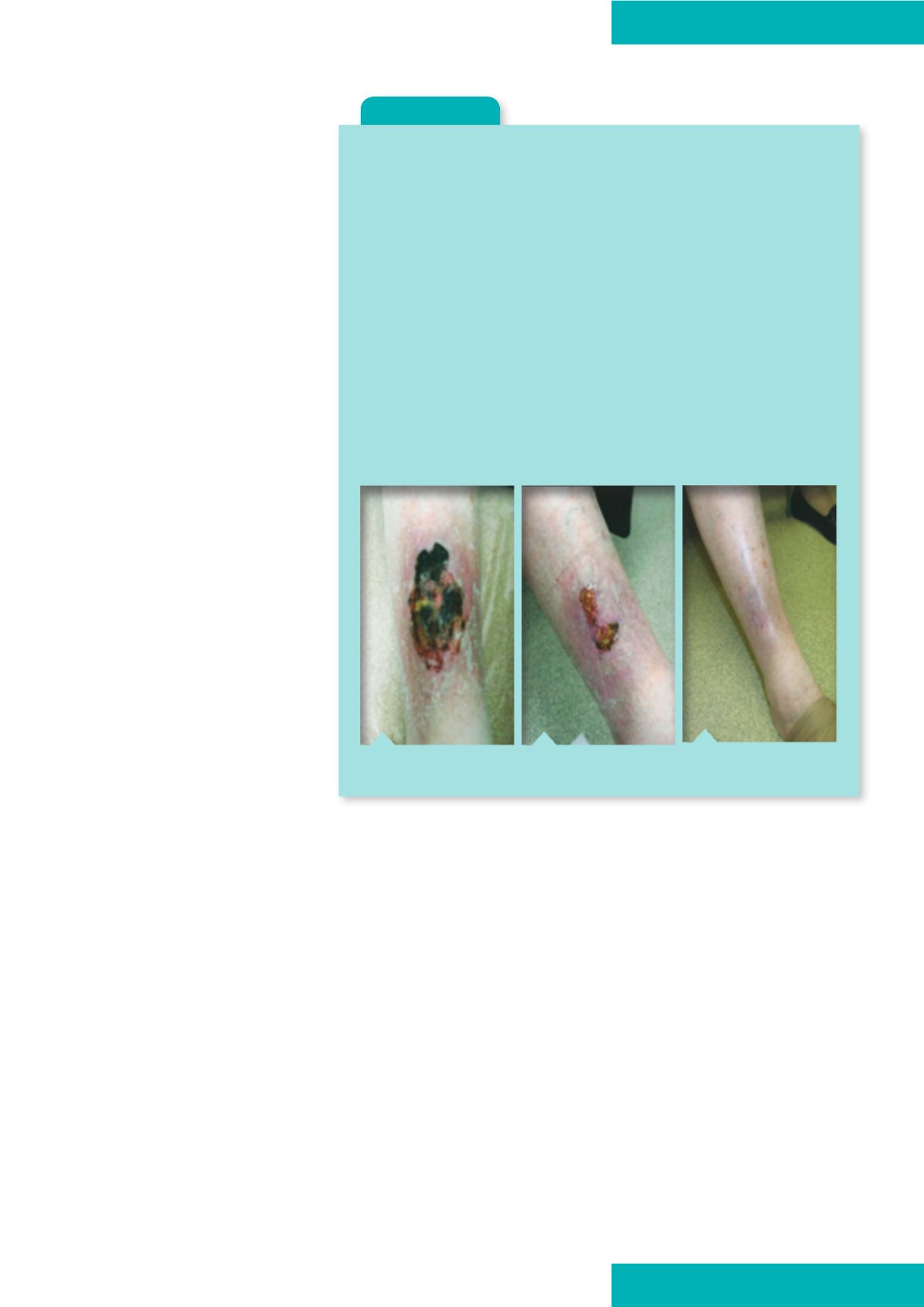

COMPRESSION THERAPY
Beldon P (2013) Compression therapy for
venous leg ulceration: Part 4 – hosiery
kits and maintenance hosiery.
Wound
Essentials
8(2):
34–8
Beston K (2012)
A case study to highlight
the ever-changing needs of a chronic
wound
. Poster presentation, Tissue
Viability Society Conference,
Kettering
Bianchi J (2013) The CHROSS Checker:
a toolkit to detect early skin
changes associated with venous and
lymphovenous disease.
J Community
Nurs
27(4):
43–9
Flanagan M (2005) Barriers to the
implementation of evidence-based
wound care.
Wounds UK
1(1):
74–82
Gray D (2013) Achieving compression
therapy concordance in the new NHS:
a challenge for clinicians.
J Community
Nurs
27(4):
107–10
Jones J (2014) In practice: implementing
a treatment pathway for compression.
In:
Two-component compression:
Concordance, evidence and clinical use
.
Wounds UK, London: 11–14. Available
online:
http://www.wounds-uk.com/pdf/content_11383.pdf (last accessed 20
October 2014)
Knowles A (2014) Key features and
innovations in compression systems.
In:
Two-component compression:
Concordance, evidence and clinical use
.
Wounds UK, London: 6–10. Available
online:
http://www.wounds-uk.com/pdf/content_11383.pdf (last accessed 20
October 2014)
Lymphoedema Framework (2006)
Best Practice for the Management of
Lymphoedema
. International consensus.
MEP Ltd, London
Moffatt C (2014) Compression therapy: a
dramatic intervention in health care.
J
Wound Care
23(4a):
S3
McNichol E (2014) Involving patients
with leg ulcers in developing
innovations in treatment and
management strategies.
Br J Community
Nurs
19(9):
S27–32
O’Brien J, Finlayson K, Kerr G, Edwards
H (2014) The perspectives of adults
with venous leg ulcers on exercise: an
exploratory study.
J Wound Care
23(10):
496–509
O’Meara, Cullum N, Nelson EA,
Dumville JC (2012) Compression
for venous leg ulcers. Cochrane
Database Syst Rev. 2012
Nov 14;11:CD000265. doi:
10.1002/14651858.CD000265.pub3
Puffet N, Martin L, Chow MK (2006)
Cohesive short-stretch vs four-layer
bandages for venous leg ulcers.
Br J
Community Nurs
11(6):
S6, S8, S10–11
Royal College of Nursing (2006)
Clinical
Practice Guidelines. The Nursing
Management of Patients with Venous Leg
Ulcers. Recommendations
. RCN, London
Sackett DL, Rosenberg WM, Gray JA,
Haynes RB, Richardson WS (1996)
Evidence-based medicine: what it is
and what it isn’t.
Br Med J
312(7023):
71–2
Scottish Intercollegiate Guidelines Network
(2010)
Management of Chronic Venous Leg
Ulcers
. SIGN, Edinburgh. Available online:
www.sign.ac.uk/pdf/sign120.pdf(last
accessed 20 October 2014)
Stephen-Haynes J, Sykes R (2013) Audit
of the use of compression hosiery in two
NHS Trusts.
Wounds UK
9(1):
16–20
Tinkler M, Hoy L, Martin D (2014)
A framework for challenging deficits
in compression bandaging techniques.
Br J Community Nurs
19(9):
S14–21
White J (2013) Beware the rituals —
look for evidence behind your actions.
Nurs Times
9 April. Available online:
http://www.nursingtimes.net/jean-white-beware-the-rituals-look-for-
evidence-behind-your-actions/5057017.
article (last accessed 20 October 2014)
Williams (2014) Prevention and
management of wounds using
compression therapy.
Br J Nurs
23(15):
S24–26
World Union of Wound Healing
Societies (2008)
Principles of Best
Practice: Compression in Venous Leg
Ul
cers
. A Consensus Document
. MEP Ltd,
London
A 68-year-old female presented to her practice nurse with a
haematoma following a fall. She had a past medical history of
hypertension, osteoarthritis and myocardial infarction.
Following initial assessment, it was identified that the primary goal of
treatment was debridement (
Figure 2
). A sheet hydrogel, along with
compression bandaging was used to achieve this objective. At the end
of the fifth week, the healing process slowed and signs of localised
wound infection were apparent. A topical antimicrobial dressing was
then used for a period of two weeks to manage the signs of infection
with good effect.
The wound continued to improve
(Figure 3
) and healing was achieved
within a period of five months. A step-down approach to an Activa
Leg Ulcer hosiery kit was adopted to allow the patient to continue
with compression therapy, without the bulk of bandaging to facilitate
quality of life improvements
(Figure 4)
.
Case report
Figure 2.
Figure 3.
Figure 4.
JCN supplement
2014,Vol 28, No 6
13
















